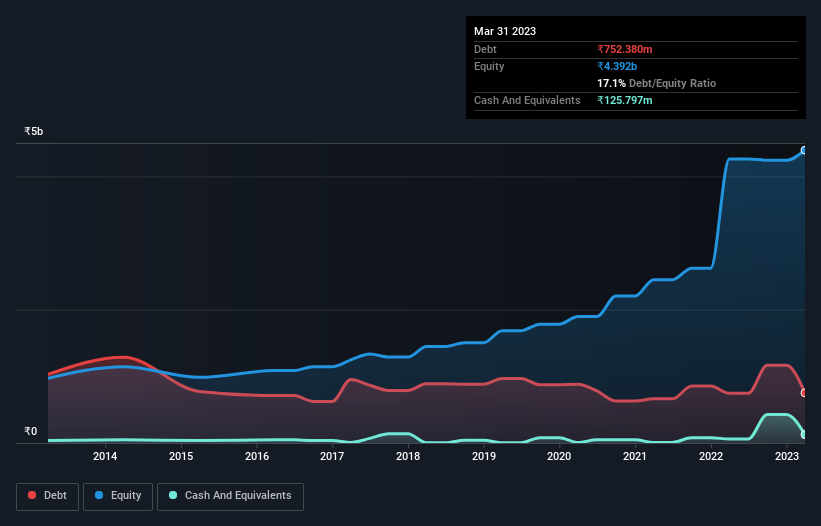David Iben put it well when he said, 'Volatility is not a risk we care about. What we care about is avoiding the permanent loss of capital.' When we think about how risky a company is, we always like to look at its use of debt, since debt overload can lead to ruin. Importantly, Kopran Limited (NSE:KOPRAN) does carry debt. But is this debt a concern to shareholders?
What Risk Does Debt Bring?
Debt assists a business until the business has trouble paying it off, either with new capital or with free cash flow. In the worst case scenario, a company can go bankrupt if it cannot pay its creditors. However, a more frequent (but still costly) occurrence is where a company must issue shares at bargain-basement prices, permanently diluting shareholders, just to shore up its balance sheet. Of course, the upside of debt is that it often represents cheap capital, especially when it replaces dilution in a company with the ability to reinvest at high rates of return. When we examine debt levels, we first consider both cash and debt levels, together.
See our latest analysis for Kopran
What Is Kopran's Debt?
The chart below, which you can click on for greater detail, shows that Kopran had ₹752.4m in debt in March 2023; about the same as the year before. However, because it has a cash reserve of ₹125.8m, its net debt is less, at about ₹626.6m.

How Healthy Is Kopran's Balance Sheet?
We can see from the most recent balance sheet that Kopran had liabilities of ₹1.77b falling due within a year, and liabilities of ₹334.8m due beyond that. On the other hand, it had cash of ₹125.8m and ₹1.64b worth of receivables due within a year. So it has liabilities totalling ₹335.3m more than its cash and near-term receivables, combined.
Given Kopran has a market capitalization of ₹8.64b, it's hard to believe these liabilities pose much threat. However, we do think it is worth keeping an eye on its balance sheet strength, as it may change over time.
We measure a company's debt load relative to its earnings power by looking at its net debt divided by its earnings before interest, tax, depreciation, and amortization (EBITDA) and by calculating how easily its earnings before interest and tax (EBIT) cover its interest expense (interest cover). This way, we consider both the absolute quantum of the debt, as well as the interest rates paid on it.
With net debt sitting at just 1.0 times EBITDA, Kopran is arguably pretty conservatively geared. And this view is supported by the solid interest coverage, with EBIT coming in at 7.8 times the interest expense over the last year. The modesty of its debt load may become crucial for Kopran if management cannot prevent a repeat of the 38% cut to EBIT over the last year. Falling earnings (if the trend continues) could eventually make even modest debt quite risky. The balance sheet is clearly the area to focus on when you are analysing debt. But it is Kopran's earnings that will influence how the balance sheet holds up in the future. So when considering debt, it's definitely worth looking at the earnings trend. Click here for an interactive snapshot.
But our final consideration is also important, because a company cannot pay debt with paper profits; it needs cold hard cash. So we always check how much of that EBIT is translated into free cash flow. During the last three years, Kopran burned a lot of cash. While investors are no doubt expecting a reversal of that situation in due course, it clearly does mean its use of debt is more risky.
Our View
While Kopran's conversion of EBIT to free cash flow makes us cautious about it, its track record of (not) growing its EBIT is no better. But its not so bad at managing its debt, based on its EBITDA,. When we consider all the factors discussed, it seems to us that Kopran is taking some risks with its use of debt. So while that leverage does boost returns on equity, we wouldn't really want to see it increase from here. The balance sheet is clearly the area to focus on when you are analysing debt. However, not all investment risk resides within the balance sheet - far from it. To that end, you should be aware of the 3 warning signs we've spotted with Kopran .
At the end of the day, it's often better to focus on companies that are free from net debt. You can access our special list of such companies (all with a track record of profit growth). It's free.
Valuation is complex, but we're here to simplify it.
Discover if Kopran might be undervalued or overvalued with our detailed analysis, featuring fair value estimates, potential risks, dividends, insider trades, and its financial condition.
Access Free AnalysisHave feedback on this article? Concerned about the content? Get in touch with us directly. Alternatively, email editorial-team (at) simplywallst.com.
This article by Simply Wall St is general in nature. We provide commentary based on historical data and analyst forecasts only using an unbiased methodology and our articles are not intended to be financial advice. It does not constitute a recommendation to buy or sell any stock, and does not take account of your objectives, or your financial situation. We aim to bring you long-term focused analysis driven by fundamental data. Note that our analysis may not factor in the latest price-sensitive company announcements or qualitative material. Simply Wall St has no position in any stocks mentioned.
About NSEI:KOPRAN
Kopran
An integrated pharmaceutical company, engages in the development, manufacture and marketing of active pharmaceutical ingredients and finished dosage forms in India and internationally.
Excellent balance sheet average dividend payer.
Market Insights
Community Narratives




